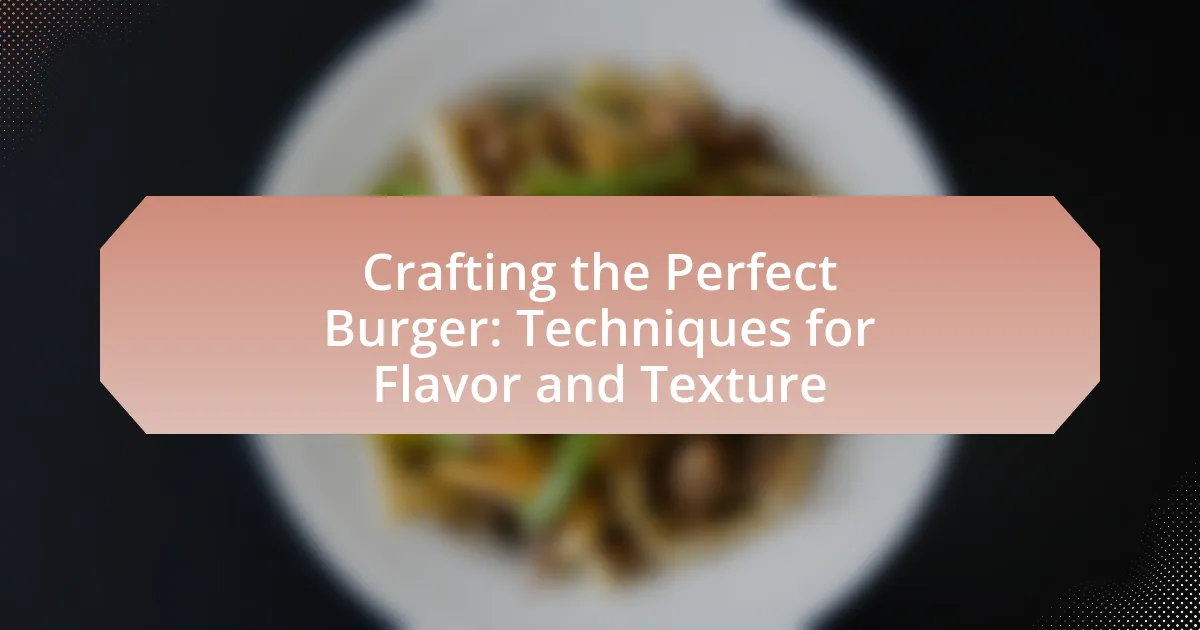The article focuses on the essential components and techniques for crafting the perfect burger, emphasizing the importance of a high-quality beef patty, fresh toppings, suitable buns, and complementary condiments. It explores how the choice of meat, particularly fat content, influences flavor and texture, while also discussing the role of seasonings and marinades in enhancing taste and tenderness. Additionally, the article examines various cooking methods, patty formation techniques, and the impact of toppings and cheeses on the overall burger experience, providing practical tips for achieving optimal flavor and texture in burger preparation.

What are the essential components of crafting the perfect burger?
The essential components of crafting the perfect burger include a high-quality beef patty, fresh toppings, a suitable bun, and complementary condiments. The beef patty should ideally be made from ground chuck with a fat content of around 20% to ensure juiciness and flavor. Fresh toppings such as lettuce, tomato, onions, and pickles add texture and freshness, while the bun should be soft yet sturdy enough to hold the ingredients without falling apart. Condiments like ketchup, mustard, and mayonnaise enhance the overall flavor profile, creating a balanced taste experience. These components work together to create a satisfying burger that appeals to a wide range of palates.
How does the choice of meat influence burger flavor and texture?
The choice of meat significantly influences burger flavor and texture by determining fat content, protein structure, and overall taste profile. For instance, beef, particularly cuts with higher fat content like chuck, provides a rich, juicy flavor and a tender texture due to the marbling of fat, which melts during cooking. In contrast, lean meats such as turkey or chicken yield a drier texture and milder flavor, often requiring additional ingredients like spices or fats to enhance taste. Additionally, the specific type of beef, such as Wagyu or Angus, can introduce unique flavor notes due to their distinct breeding and feeding practices. Studies have shown that the fat content in meat directly correlates with flavor intensity, as fat carries flavor compounds, making higher-fat meats more flavorful.
What types of meat are best for burgers?
Beef is the best type of meat for burgers, particularly ground chuck, which contains about 15-20% fat, providing optimal flavor and juiciness. This fat content is essential for creating a rich taste and a satisfying texture, as it helps to keep the burger moist during cooking. Additionally, other meats such as lamb, turkey, and pork can also be used for burgers, but they typically require different preparation methods and seasoning to achieve a desirable flavor profile. Ground beef remains the most popular choice due to its balance of flavor, fat content, and texture, making it the standard for classic burgers.
How does fat content affect the juiciness of a burger?
Fat content significantly affects the juiciness of a burger, as higher fat levels lead to increased moisture retention during cooking. When a burger contains around 20% fat, it provides a balance that allows for flavorful juices to be released while cooking, resulting in a moist and tender texture. Research indicates that fat acts as a flavor carrier and contributes to the overall mouthfeel, enhancing the eating experience. For instance, a study published in the Journal of Food Science found that burgers with higher fat content (specifically 20% fat) were rated significantly higher in juiciness compared to leaner options (10% fat). This demonstrates that adequate fat content is crucial for achieving the desired juiciness in burgers.
What role do seasonings and marinades play in burger preparation?
Seasonings and marinades are essential in burger preparation as they enhance flavor and tenderness. Seasonings, such as salt, pepper, and various spices, contribute to the overall taste profile, while marinades, which often include acidic components like vinegar or citrus, help to tenderize the meat and infuse it with additional flavors. Research indicates that marinating meat can increase moisture retention and improve texture, making the burger juicier and more flavorful. For instance, a study published in the Journal of Food Science found that marinated meats exhibited a significant increase in juiciness compared to non-marinated counterparts. Thus, the strategic use of seasonings and marinades is crucial for achieving a well-balanced and enjoyable burger.
Which spices enhance the flavor profile of a burger?
Spices that enhance the flavor profile of a burger include black pepper, garlic powder, onion powder, smoked paprika, and cumin. Black pepper adds heat and depth, while garlic powder and onion powder contribute savory notes that complement the meat. Smoked paprika introduces a subtle smokiness, enhancing the overall flavor, and cumin adds an earthy warmth. These spices are commonly used in burger seasoning blends, which have been shown to elevate the taste experience significantly, making burgers more appealing to consumers.
How can marinades improve tenderness and taste?
Marinades improve tenderness and taste by breaking down proteins and infusing flavors into the meat. The acidic components in marinades, such as vinegar or citrus juice, denature proteins, making them more tender. Additionally, marinades often contain herbs, spices, and oils that enhance the flavor profile of the meat. Research indicates that marinating can increase moisture retention, leading to juicier results. For example, a study published in the Journal of Food Science found that marinated meats had significantly higher moisture content compared to non-marinated counterparts, demonstrating the effectiveness of marinades in enhancing both tenderness and taste.

What techniques can be used to achieve the ideal burger texture?
To achieve the ideal burger texture, techniques such as selecting the right meat blend, proper seasoning, and cooking methods are essential. Using a blend of ground beef with a fat content of around 20% enhances juiciness and flavor, while also contributing to a tender texture. Seasoning the meat just before cooking, rather than during mixing, helps maintain moisture and prevents the proteins from becoming too compacted. Cooking the burger on high heat, either through grilling or pan-searing, creates a desirable crust while keeping the inside juicy. Additionally, allowing the burger to rest after cooking helps redistribute the juices, further improving the texture. These techniques are supported by culinary studies that emphasize the importance of fat content and cooking methods in achieving optimal burger quality.
How does cooking method impact the final burger texture?
Cooking method significantly impacts the final burger texture by influencing moisture retention, fat rendering, and the Maillard reaction. Grilling typically results in a firmer texture due to high heat, which creates a crust while sealing in juices. In contrast, pan-frying can lead to a softer texture as the burger cooks in its own fat, allowing for more moisture retention. Additionally, sous-vide cooking produces a tender texture by cooking the burger evenly at a controlled temperature, preventing overcooking. The Maillard reaction, which occurs at higher temperatures, enhances the crust and overall mouthfeel, contributing to a desirable texture. Studies show that cooking methods like grilling and broiling can create a more pronounced crust compared to methods like steaming, which results in a softer, less textured burger.
What are the differences between grilling, frying, and broiling burgers?
Grilling, frying, and broiling burgers differ primarily in their cooking methods and resulting flavors. Grilling involves cooking burgers over an open flame or hot coals, which imparts a smoky flavor and creates a charred exterior while keeping the interior juicy. Frying, on the other hand, cooks burgers in oil on a stovetop, resulting in a crispy crust and a rich flavor due to the fat absorption. Broiling uses high heat from above, typically in an oven, which cooks burgers quickly and can create a caramelized surface while maintaining moisture inside. Each method affects the texture and taste of the burger, with grilling providing a distinct outdoor flavor, frying offering a hearty richness, and broiling delivering a quick, intense heat that can enhance the burger’s natural flavors.
How can cooking temperature affect doneness and texture?
Cooking temperature significantly influences both doneness and texture in food preparation. Higher cooking temperatures typically result in a more well-done product, as proteins coagulate and moisture evaporates, leading to a firmer texture. For instance, cooking ground beef at temperatures above 160°F (71°C) ensures that it reaches a safe internal temperature, but can also lead to a dry and tough texture due to moisture loss. Conversely, lower cooking temperatures, such as those used in sous-vide techniques, allow for even cooking and retention of moisture, resulting in a tender and juicy texture while achieving desired doneness levels. This relationship between temperature and texture is supported by culinary science, which indicates that the Maillard reaction, responsible for browning and flavor development, occurs optimally between 300°F and 500°F (149°C to 260°C), further affecting the overall eating experience.
What are the best practices for forming burger patties?
The best practices for forming burger patties include using cold meat, handling the meat minimally, and creating a slight indentation in the center of each patty. Cold meat helps maintain the fat structure, which is crucial for juiciness during cooking. Minimally handling the meat prevents the proteins from becoming too compact, resulting in a tender texture. The indentation compensates for puffing during cooking, ensuring even cooking and a flat surface. These techniques are supported by culinary experts who emphasize the importance of temperature and handling in achieving optimal burger quality.
How does patty thickness influence cooking time and texture?
Patty thickness significantly influences both cooking time and texture. Thicker patties require longer cooking times to ensure that the center reaches a safe temperature, while thinner patties cook more quickly, often resulting in a firmer texture. For instance, a typical 1-inch thick beef patty may take about 8-10 minutes to cook to medium doneness, whereas a ¼-inch patty may only need 3-4 minutes. This difference in cooking time affects moisture retention; thicker patties tend to retain more juices, leading to a juicier texture, while thinner patties can dry out more easily.
What techniques can prevent burgers from falling apart during cooking?
To prevent burgers from falling apart during cooking, use techniques such as selecting the right meat-to-fat ratio, handling the meat minimally, and chilling the patties before cooking. A meat-to-fat ratio of 80/20 is optimal, as the fat helps bind the meat and adds moisture. Minimally handling the meat reduces the risk of overworking it, which can lead to a dense texture that crumbles. Chilling the patties for at least 30 minutes before cooking firms them up, making them less likely to break apart on the grill or in the pan. These methods are supported by culinary practices that emphasize the importance of fat content and temperature in maintaining burger integrity.

What toppings and condiments complement the perfect burger?
The perfect burger is complemented by toppings such as lettuce, tomato, onion, pickles, cheese, and bacon, along with condiments like ketchup, mustard, mayonnaise, and barbecue sauce. These ingredients enhance flavor and texture, creating a balanced and satisfying experience. For instance, lettuce adds crunch, tomatoes provide juiciness, and cheese contributes creaminess, while condiments like ketchup and mustard offer tanginess that contrasts with the savory meat. This combination is widely recognized in culinary practices, as evidenced by the popularity of these toppings in various burger recipes across restaurants and cookbooks.
How do different cheeses enhance burger flavor?
Different cheeses enhance burger flavor by adding unique taste profiles, textures, and aromas that complement the meat. For instance, sharp cheddar provides a tangy richness, while blue cheese introduces a bold, creamy element that contrasts with the savory beef. Additionally, Swiss cheese offers a nutty flavor and melts beautifully, creating a smooth texture that enhances the overall mouthfeel. The melting properties of cheeses like mozzarella or gouda also contribute to a satisfying experience, as they create a gooey layer that binds the ingredients together. Studies show that cheese can elevate the sensory experience of a burger, making it more enjoyable and flavorful.
What are the best cheese options for melting on burgers?
The best cheese options for melting on burgers include American cheese, cheddar cheese, Swiss cheese, and pepper jack cheese. American cheese is favored for its excellent melting properties and creamy texture, making it a classic choice for burgers. Cheddar cheese, particularly when aged, offers a sharp flavor that complements the meat while still melting well. Swiss cheese provides a mild, nutty taste and melts smoothly, enhancing the burger experience. Pepper jack cheese adds a spicy kick, appealing to those who enjoy a bit of heat. These cheeses are widely recognized for their melting qualities, making them ideal for creating flavorful, gooey toppings on burgers.
How does cheese choice affect overall taste and texture?
Cheese choice significantly influences the overall taste and texture of a burger. Different cheeses provide varying flavors, ranging from sharp and tangy to creamy and mild, which can enhance or complement the burger’s meat and toppings. For example, cheddar adds a robust flavor, while Swiss offers a nutty taste, and blue cheese introduces a bold, pungent profile.
Texture also varies with cheese selection; for instance, a melted mozzarella creates a gooey, stretchy texture, while a crumbly feta adds a contrasting bite. The melting point of cheese affects how it interacts with the burger; cheeses like American melt smoothly, creating a cohesive experience, whereas harder cheeses may not melt as thoroughly, maintaining their distinct texture.
Research indicates that cheese varieties can alter the sensory perception of a dish, impacting both flavor and mouthfeel, which is crucial in crafting the perfect burger.
What are the most popular toppings for burgers?
The most popular toppings for burgers include lettuce, tomato, onion, cheese, pickles, and bacon. These toppings enhance the flavor and texture of the burger, making them widely favored among consumers. For instance, a survey by the National Restaurant Association found that 75% of burger lovers prefer cheese, while 60% opt for lettuce and tomato. Additionally, bacon adds a savory element that appeals to many, contributing to its popularity.
How do fresh vegetables contribute to burger flavor and crunch?
Fresh vegetables enhance burger flavor and crunch by providing a variety of textures and tastes that complement the meat. Ingredients like lettuce, tomatoes, onions, and pickles add crispness and juiciness, which contrast with the savory richness of the burger patty. For instance, lettuce contributes a refreshing crunch, while tomatoes offer moisture and acidity, balancing the overall flavor profile. Studies show that the inclusion of fresh vegetables can increase the sensory appeal of burgers, making them more enjoyable to eat.
What unique toppings can elevate a classic burger experience?
Unique toppings that can elevate a classic burger experience include caramelized onions, avocado, fried eggs, blue cheese, and jalapeños. Caramelized onions add a sweet and savory depth, while avocado provides creaminess and healthy fats. A fried egg introduces richness and a unique texture, blue cheese offers a sharp and tangy flavor contrast, and jalapeños contribute heat and crunch. These toppings not only enhance the flavor profile but also create a more complex and satisfying eating experience.
What tips can help ensure a successful burger-making experience?
To ensure a successful burger-making experience, start with high-quality ingredients, particularly fresh ground beef with a fat content of around 20% for optimal flavor and juiciness. Properly season the meat with salt and pepper just before cooking to enhance taste without drawing out moisture. Form patties gently without overworking the meat, creating a slight indentation in the center to prevent puffing during cooking. Preheat the grill or skillet to a high temperature to achieve a good sear, which locks in juices and adds flavor. Cook the burgers to the desired doneness, using a meat thermometer to ensure safety; ground beef should reach an internal temperature of 160°F. Finally, let the burgers rest for a few minutes before serving to allow juices to redistribute, enhancing overall flavor and texture.


